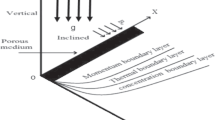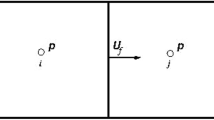Abstract
Motivated by several applications such as thermal management of electronic components, the design and modeling of heat exchangers, etc. this work presents an efficient monolithic finite element strategy for solving thermo-fluid-structure interaction problems involving a compressible fluid and a structure undergoing small deformations. This formulation uses displacement variables for the structure and velocity variables for the fluid, with no additional variables required to ensure traction, velocity, temperature and heat flux continuity at the fluid-structure interface. The use of an exact tangent stiffness matrix ensures a quadratic rate of convergence within each time step. The robustness and good performance of the method is demonstrated by applying the proposed strategy to a wide spectrum of problems pertaining to steady/transient, two/three-dimensional/axisymmetric problems involving conjugate heat transfer. In particular, it is shown that the proposed formulation yields good results even when the fluid is almost incompressible.

































































Similar content being viewed by others
References
John M House, Christoph Beckerman and Theodore F Smith 1990 Effect of a centered conducting body on natural convection on natural convection heat transfer in an enclosure. Numerical Heat Transfer, Part A : Applications : An International Journal of Computation and Methodology. 18: 213–225
Jong Yun Oh, Man Yeong Ha and Kyung Chun Kim 1997 Numerical study of heat transfer and flow of natural convection in an enclosure with a heat generating conducting body. Numerical Heat Transfer, Part A : Applications : An International Journal of Computation and Methodology. 31: 289–303
Yang L M, Shu C, Chen Z and Wu J 2020 Three-dimensional lattice Boltzmann flux solver for simulation of fluid-solid conjugate heat transfer problems with curved boundary. Physical Review. E 101, 053309: 1–15
Man Yeong Ha and Mi Jung Jung 2000 A numerical study on three-dimensional conjugate heat transfer of natural convection and conduction in a differentially heated cubic enclosure with a heat-generating cubic conducting body. International Journal of Heat and Mass Transfer. 43: 4229–4248
Man Yeong Ha, Mi Jung Jung and Young Soo Kim 1999 Numerical study on transient heat transfer and fluid flow of natural convection in an enclosure with a heat-generating conducting body. Numerical Heat Transfer, Part A: Applications. 35: 415–433
Purusothaman A and Murugesan K and Ali J Chamkha 2019 3D modeling of natural convective heat transfer from a varying rectangular heat generating source. Journal of Thermal Analysis and Calorimetry. 138: 597–608
Yan Yan and David E Keyes 2015 Smooth and robust solutions for Dirichlet boundary control of fluid-solid conjugate heat transfer problems. Journal of Computational Physics. 281: 759–786
William D Henshaw and Kyle K Chand 2009 A composite grid solver for conjugate heat transfer in fluid–structure systems. Journal of Computational Physics. 228: 3708–3741
Habchi S and Acharya S 1986 Laminar mixed convection in a partially blocked, vertical channel. International Journal of Heat Mass Transfer. 29: 1711–1722
Adel Hamouche and Rachid Bessaih 2009 Mixed convection air cooling of protruding heat sources mounted in a horizontal channel. International Communications in Heat and Mass Transfer. 36: 841–849
Bathe K J and Dong J 1989 Studies of finite element procedures - The use of ADINA-F in fluid flow analyses. Computers and Structures. 32: 499–516
Timothy J Young and Kambiz Vafzai 1998 Convective cooling of a heated obstacle in a channel. International Journal of Heat Mass Transfer. 41: 3131–3148
Premachandran B and Balaji C 2005 Mixed convection heat transfer from a horizontal channel with protruding heat sources. Heat Mass Transfer. 41: 510–518
Kazemi-Kamyab V, Van Zuijlen A H and Bijl H 2013 A high order time-accurate loosely-coupled solution algorithm for unsteady conjugate heat transfer problems. Comput. Methods Appl. Mech. Engrg. 264: 205–217
Xiaomin Pan, Changhoon Lee and Jung-ll Choi 2018 Efficient monolithic projection method for time-dependent conjugate heat transfer problems. Journal of Computational Physics. 369: 191–208
Kaminski D A and Prakash C 1986 Conjugate natural convection in a square enclosure : effect of conduction in one of the vertical walls. Int. J. Heat Mass Transfer. 29: 1979–1988
Matjaz Ramsak 2015 Conjugate heat transfer of backward-facing step flow: A benchmark problem revisited. International Journal of Heat and Mass Transfer. 84: 791–799
Nouri-Borujerdi Ali and Arash Moazezi 2017 Investigation of obstacle effect to improve conjugate heat transfer in backward facing step channel using fast simulation of incompressible flow. Heat Mass Transfer. 54: 135–150
Shankar Durgam, Venkateshan S P and Sundararajan T 2019 Conjugate Forced Convection from Heat Sources on Substrates of Different Thermal Conductivity. Journal of Thermophysics and Heat Transfer. 1–13
Shankar Durgam, Venkateshan S P and Sundararajan T 2020 Effect of Thermal Conductivity on Cooling of Square Heat Source Array under Natural Convection in a Vertical Channel. Heat Transfer Engineering (Taylor & Francis). 41: 947–960
Alvarado-Juárez R, Montiel-González M, Villafán-Vidales H I, Estrada C A and Flores-Navarrete J 2020 Experimental and numerical study of conjugate heat transfer in an open square-cavity solar receiver. International Journal of Thermal Sciences. 156: 106458
Barozzi G S and Corticelli M A 2000 Natural convection in cavities containing internal sources. Heat and Mass Transfer 36: 473–480
Debasish Mishra, Muralidhar K and Ghoshdastidar P S 1995 Computation of flow and heat transfer around a vertical discrete protruding heater using an operator-splitting algorithm. Numerical Heat Transfer, Part A: Applications. 28: 103–119
Madhusudhana G Rao and G S V L Narasimham 2007 Laminar mixed convection in a vertical channel with heat generating components. International Journal of Heat and Mass Transfer 50: 3561–3574
Apurv Kumar and Balaji Chakravarthy 2011 ANN based estimation of heat generation from multiple protruding heat sources on a vertical plate under conjugate mixed convection. International Journal of Thermal Sciences. 50: 532–543
Lyes Boutina and Rachid Bessaih 2011 Numerical simulation of mixed convection air-cooling of electronic components mounted in an inclined channel. Applied Thermal Engineering. 31: 2052–2062
Ramesh Sugavanam, Alfonso Ortega and Choi C Y 1995 A numerical investigation of conjugate heat transfer from a flush heat source on a conductive board in laminar channel fl . International Journal of Heat and Mass Transfer. 38: 2969–2984
Yonglin Ju and Zhongqi Chen 1996 Numerical simulation of natural convection in an enclosure with discrete protruding sources. Numerical Heat Transfer, Part A: Applications. 30: 207–218
Dutta S and Jog C S 2021 A monolithic arbitrary Lagrangian-Eulerian-based finite element strategy for fluid-structure interaction problems involving a compressible fluid. International Journal for Numerical Method in Engineering. 122: 6037–6102
Pian T. H H and Tong P 1986 Relations between incompatible displacement model and hybrid stress model. International Journal for Numerical Methods in Engineering. 22: 173–181
Pian T H H and Sumihara K 1984 Rational approach for assumed stress finite elements. International Journal for Numerical Methods in Engineering. 20: 1685–1695
Jog C S 2010 Improved hybrid elements for structural analysis. Journal of Mechanics of Materials and Structures. 5: 507–528
Jog C S 2005 A 27 node hybrid brick and a 21 node hybrid wedge element for structural analysis. Finite Elements in Analysis and Design. 41: 1209–1232
Prathap G and Naganarayana B P 1995 Consistent thermal stress evaluation in finite elements. Computers and Structures. 54: 415–426
Miranda S and Ubertini F 2001 On the consistency of finite element models in thermoelastic analysis. Computer Methods in Applied Mechanics and Engineering. 190: 2411–2427
Jog C S 2011 A finite element method for compressible viscous fluid flows. International Journal for Numerical Methods in Fluids. 66: 852–874
Gupta Anshul 2000 WSMP : Watson Sparse Matrix Package Part II - direct solution of general sparse systems. IBM Research Report RC: 21888
Gupta Anshul 2002 Recent advances in direct methods for solving unsymmetric sparse systems of linear equations. ACM Transcations on Mathematical Software. 28: 301–324
Boley B A 1956 Thermally induced vibrations of beams. Journal of Aerospace Sciences. 23: 179–181
Manolis G D and Beskos D E 1980 Thermally induced vibrations of beam structures. Computer Methods in Applied Mechanics and Engineering. 21: 337–355
An C, Vieira C B and Su J 2013 Integral transform solution of natural convection in a square cavity with volumetric heat generation. Brazilian Journal of Chemical Engineering. 30: 833–896
Zhonglu Lin, Ahmed A Sheikh Al-Shabab, Dimitrios Vitlaris, Panagiotis, Tsoutsanis, Antonis Antoniadis and Martin Skote 2015 Effects of Heat-Conductive Obstacles on Conjugate Heat Transfer of Backward-Facing Step Flow. AIAA Scitech 2021 Forum : 1–12
COMSOL Inc, Stockholm, Sweden. 2020. COMSOL Multiphysics Reference Manual, version 5.5
Lyons C G 1996 A simple equation of state for dense fluids. Journal of Molecular Liquids. 69: 269–281
Author information
Authors and Affiliations
Corresponding author
Appendix I. An appendix section
Appendix I. An appendix section
The equations of state used are as follows:
Air: The reference values used are \(\rho =1.2\ \mathrm{kg}/\mathrm{m}^{3}\), \(\theta =300\,\text {K}\), \(p=1.0332\times 10^5\ \mathrm{N}/\mathrm{m}^{2}\), \(\lambda =-1.2\times 10^{-5}\,\text {kg/(m-s)}\), \(\mu =1.81\times 10^{-5}\,\text {kg/(m-s)}\), \(\kappa =0.025\,\text {W/m-K}\), \(c_v=717.5\,\text {J/kg-K}\), \(\gamma =1.4\).
Equation of state with \(R=287\,\text {J/(kg-K)}\) is
Dependence of viscosity (Sutherland model) and thermal conductivity on temperature:
Water: The reference values used are \(\rho =998.2\ \mathrm{kg}/\mathrm{m}^{3}\), \(\theta =293.15\,\text {K}\), \(p=1.15\times 10^5\ \mathrm{N}/\mathrm{m}^{2}\), \(\lambda =2.4\times 10^{-3}\,\text {kg/(m-s)}\), \(\mu =1.0\times 10^{-3}\,\text {kg/(m-s)}\), \(\kappa =0.6\,\text {W/m-K}\), \(c_v=4186\,\text {J/(kg-K)}\).
Equation of state: Let \(\theta _c=\theta -273.15\) and \(\theta _m=1-273.15/\theta \), and let
Then the equation of state for water is [44]
Viscosity as a function of temperature:
With
the viscosity as a function of temperature is given by
Thermal conductivity as a function of temperature: With
the thermal conductivity as a function of temperature is given by
Rights and permissions
About this article
Cite this article
Santhosh, A.K., Jog, C.S. A monolithic finite element strategy for conjugate heat transfer. Sādhanā 47, 223 (2022). https://doi.org/10.1007/s12046-022-01991-3
Received:
Revised:
Accepted:
Published:
DOI: https://doi.org/10.1007/s12046-022-01991-3




